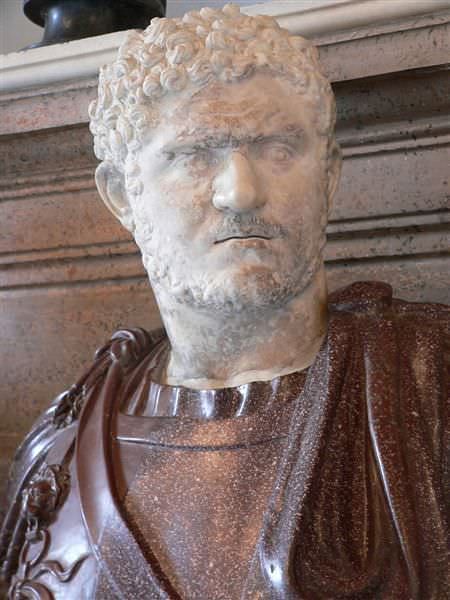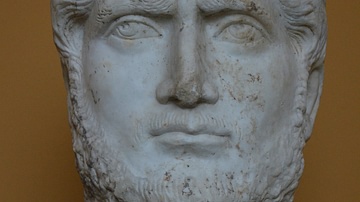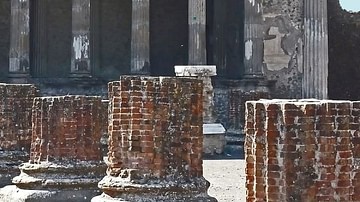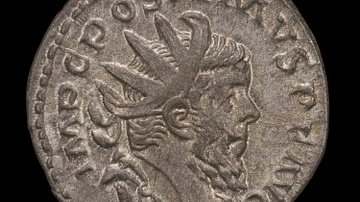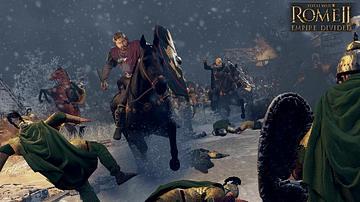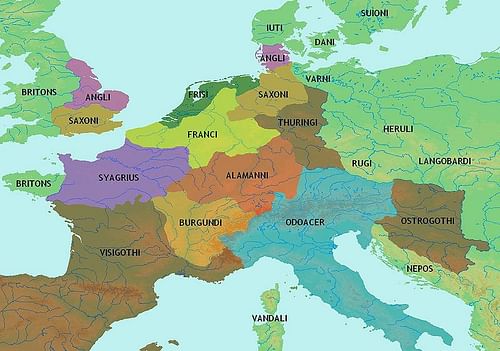
The Alemanni (also known as the Alamanni and the Alamans, meaning "All Men" or "Men United") were a confederacy of Germanic-speaking people who occupied the regions south of the Main and east of the Rhine rivers in present-day Germany. Many historians claim that the Alemanni first enter the historical record in 213 CE when Cassius Dio records the campaigns of Caracalla and his duplicitous dealings with the Alemanni. It is true that the name "Alemanni" first appears in Cassius Dio but, if one accepts that the Alemanni and the Suebi (or Suevi, who appear in earlier records) were the same (as not all do), then their first mention comes in 98 CE in Tacitus' Germania. They were a constant threat to the Roman Empire from 213 CE until they were defeated by Julian at the Battle of Strasbourg in 357 CE and then again by Valentinian I in 367 CE. After the Battle of Strasbourg, Julian entered into treaties with the Franks of Gaul, who were then left alone by Rome. They were able to stabilize their communities and grow in power until, in 496 CE, the Frankish king Clovis conquered the Alemanni tribes and absorbed them into his kingdom. After this, their name lived on in the language of the region they had once inhabited and in the name given to Germany, Allemagne, in French and other languages.
Appearance & Religion
The Roman senator and historian Tacitus (56-117 CE) wrote of the Suevi in the 1st century CE, claiming they controlled the better part of the region known as Germania. He links the Alemanni with the Hermunduri, another Germanic tribe, but this claim has been contested by modern-day scholarship. The Suevi Tacitus depicts sound very much like the later Alemanni, in that they were a confederation of different tribes, which may have even included the Cherusci (famous for their leader Arminius' destruction of Varus' three legions in the Teutoburg Forest in 9 CE). Tacitus is the first writer to note the Suevi's distinctive hairstyles and religious practices. He writes:
We have now to speak of the Suevi; who do not compose a single state, like the Catti or Tencteri, but occupy the greatest part of Germany and are still distributed into different names and nations, although all hearing the common appellation of Suevi. It is characteristic of this people to turn their hair sideways, and tie it beneath the poll in a knot.
By this mark the Suevi are distinguished from the rest of the Germans; and the freemen of the Suevi from the slaves. Among other nations, this mode, either on account of some relationship with the Suevi, or from the usual propensity to imitation, is sometimes adopted; but rarely, and only during the period of youth.
The Suevi, even till they are hoary, continue to have their hair growing stiffly backwards, and often it is fastened on the very crown of the head. The chiefs dress it with still greater care and in this respect they study ornament, though of an undebasing kind. For their design is not to make love, or inspire it; they decorate themselves in this manner as they proceed to war, in order to seem taller and more terrible; and dress for the eyes of their enemies. (Germania, 38)
Regarding religion, Tacitus writes that the Suevi were pagan and seem to have practiced a form of Druidism. Their chiefs were drawn from a tribe in the confederation known as Semnones who also served as high priests:
The Semnones assert themselves to be the most ancient and noble of the Suevi; and their pretensions are confirmed by religion. At a stated time, all the people of the same lineage assemble by their delegates in a wood, consecrated by the auguries of their forefathers and ancient terror, and there by the public slaughter of a human victim celebrate the horrid origin of their barbarous rites. Another kind of reverence is paid to the grove. No person enters it without being bound with a chain, as an acknowledgment of his inferior nature, and the power of the deity residing there. If he accidentally falls, it is not lawful for him to be lifted or to rise up; they roll themselves out along the ground. The whole of their superstition has this import: that from this spot the nation derives its origin; that here is the residence of the Deity, the Governor of all, and that everything else is subject and subordinate to him. These opinions receive additional authority from the power of the Semnones, who inhabit a hundred cantons, and, from the great body they compose, consider themselves as the head of the Suevi. (Germania, 39)
The religious practices centered on chthonic locales, then, where a central deity held sway. Rivers, streams, glades, and valleys were often chosen as sacred ground for the energies which manifested themselves in these locales. As with many other ancient civilizations, the Suevi believed the soul had to cross a body of water to reach the afterlife and that the soul lived on after death. Suevi/Alemanni grave excavations have revealed that they were buried fully dressed and with personal items that they would need in the next world. These burial practices continued after they converted to Christianity sometime between the 6th and 8th centuries CE although, of course, their religious practices changed dramatically.
The Alemanni & Rome
Although the Suevi have been identified with the later Alemanni, historians caution against equating the two without recognizing their differences over the centuries which separate Tacitus' account (98 CE) from Cassius Dio's (c. 229 CE). The scholar Guy Halsall writes, "It is unlikely that the situation which pertained in the mid-first century was at all relevant to the late Roman period. Tacitus' Germania is a minefield probably best avoided [in this regard]" (121). The scholar Peter Heather comments on this also, stating how unified the Alemanni appear in the work of Ammianus Marcellinus (c. 325-391 CE) while, "One of the central points brought home by even the quickest read of Tacitus' Germania is just how fragmented, in political terms, the Germanic world was at that date" (36). It is for this reason that historians usually cite Cassius Dio's account as the first mention of the Alemanni and ignore Tacitus' earlier description of the Suevi.
By the time of Dio's account, the Alemanni were largely Romanized from their long acquaintance with the Romans. Halsall writes how in the border region of the Danube and the Roman Empire,
some of the Alemanni, who it has been suggested were formed at least partly by the Romans themselves from inhabitants of the agri decumates [a term possibly meaning 10 agricultural regions]and authorised barbarian settlers, occupied former Roman villa sites, such as at Wurmlingen in Baden Wurttemberg (128).
The Alemanni at this time wore Roman attire and emulated Roman social customs. Even so, they were not 'Romans' in the accepted sense of that word and maintained their own language and culture. Therefore, when they asked the emperor Caracalla for help against a neighboring tribe in 213 CE, he saw no reason why he should not conquer them instead. Cassius Dio writes:
Antoninus [Caracalla] made a campaign against the Alamanni and whenever he saw a spot suitable for habitation, he would order, "There let a fort be erected. There let a city be built." And he gave these places names relating to himself, though the local designations were not changed; for some of the people were unaware of the new names and others supposed he was jesting. Consequently he came to feel contempt for these people and would not spare even them, but accorded treatment befitting the bitterest foes to the very people whom he claimed to have come to help. For he summoned their men of military age, pretending that they were to serve as mercenaries, and then at a given signal — by raising aloft his own shield — he caused them all to be surrounded and cut down, and he sent horsemen round about and arrested all the others. (78.13.4)
Whether the Alemanni were particularly hostile to Rome before this is not known, but they became one of Rome's most bitter enemies afterwards.
Engagements Against Rome
- 256 CE: Gregory of Tours (c. 538-594 CE) famously wrote of the Alemanni invasion of Gaul in 256 CE under their king Chrocus. Chrocus led his army across the land, destroying the cities, churches, towns, and slaughtering the inhabitants until he was defeated at Arles and executed. Surviving members of his army were then either killed or absorbed into the Roman ranks as mercenaries.
- 259 CE: The Alemanni invaded Italy, ravaging the fertile Po Valley, until they were defeated at the Battle of Mediolanum by a Roman force led by emperor Gallienus.
- 268 CE: The Battle of Benacus was fought in 268/269 CE between the emperor Claudius II (supported by the later Emperor Aurelian) and the Alemanni. The Alemanni, allied with the Juthungi, invaded northern Italy and were met at Benacus by the Roman forces. The Romans again decisively defeated the Alemanni, killing most of them and scattering the rest.
- 271 CE: The Alemanni and Juthungi again invaded Italy, while the emperor Aurelian was busy repulsing Vandals on the Danube frontier. He marched his forces to meet the Alemanni threat but was ambushed and defeated at the Battle of Placentia. This defeat resulted in widespread panic throughout Rome, as the Juthungi marched toward the city which had no sizeable force to protect it. Aurelian regrouped, however, and chased the Juthungi, finally meeting them at the Battle of Fano where he defeated them completely, driving them into the Metaurus River where many of them drowned. The surviving Juthungi then sued for a peace which Aurelian rejected. He pursued them and their Alemanni allies and destroyed most of the force at the Battle of Pavia. Those Alemanni who survived were hunted down and killed trying to escape back home through the province of Raetia. Although he had stopped the invasion and destroyed the enemy, Aurelian recognized the need for better defenses for Rome and so ordered a new and stronger wall built around the city.
- 298 CE: The emperor Constantius defeated the Alemanni twice at the Battle of Lingones and then again at the Battle of Vindonissa.
- 356 CE: Julian, commanding his first military force (prior to becoming emperor), was surprised and defeated by the Alemanni at the Battle of Reims.
- 357 CE: Julian defeated the Alemanni at the Battle of Strasbourg, completely overwhelming their forces and capturing one of their most important leaders, Chnodomar (also known as Chnodomarius) who had mobilized the Alemanni for battle and led them from the front. Although Julian's victory subdued the Alemanni and allowed him to march into Germania, re-build and garrison Roman forts, and force tribute from the tribes, it did not destroy the Alemanni or disperse them. Peter Heather writes:
The defeat of Chnodomarius did not mean the total destruction of the alliance at whose head he had stood, as the defeats of his first-century counterparts such as Arminius and Maroboduus had done three centuries before. Not only were many of the lesser Alamannic kings who had participated in the battle left in place by Julian's diplomacy, but, within a decade of the battle, a new pre-eminent leader, Vadomarius, was worrying the Romans. He was skillfully removed by assassination, but then a third appeared in his place: Macrinus. Ammianus records three separate attempts by one of Julian's successors, Valentinian I, to eliminate Macrinus by capture and/or assassination, but eventually, pressed by events further east, the emperor gave in. Roman and Alamann met in the middle of the Rhine for a water-borne summit, where the emperor acknowledged Macrinus' pre-eminence among the Alamanni. Unlike in the first century, even major military defeat was not enough to destroy the larger Alamannic confederation. (40-41)
The "major military defeat" Heather refers to is not only the Battle of Strasbourg but the later Battle of Solicinium in 367 CE, in which Valentinian I defeated the Alemanni in the southwestern region of Germany. Even though he was victorious, the Alemanni were by no means broken and were still a formidable force some 80 years later when they joined the forces of Attila the Hun and took part in the Battle of the Catalaunian Plains against the Romans under Flavius Aetius in 451 CE. Even so, the Battle of Strasbourg severely limited their abilities to threaten Rome for years after. The historian Roger Collins writes,
This single battle really turned the tide as far as the Alaman penetration of Gaul was concerned. It broke the Alamannic confederacy of tribes that had largely been built up and held together by the military credibility of Chnodomar, and for the first time enabled the Romans to take the initiative…Threatened with a Roman invasion of their own territory, the Alamans sought a truce. (35)
Again, however, it must be noted that the confederacy was not disbanded nor did the Alemanni seem to consider themselves a conquered people.
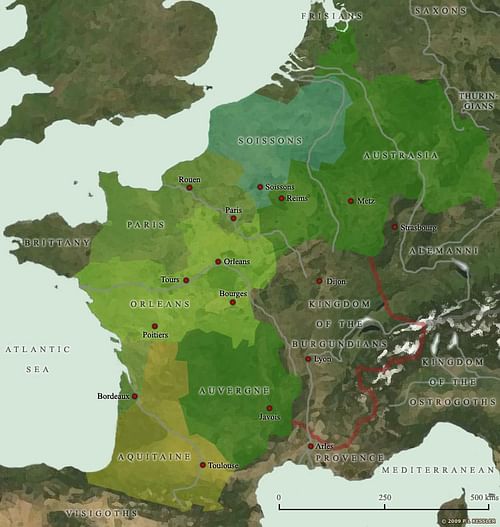
The Frankish Conquest of the Alemanni
First Julian, and then Valentinian I, entered into treaties with the confederacy of the people known as the Franks ("the fierce people"). In an effort to maintain the newly restored Roman city of Cologne, Julian blockaded the territory of the Franks, depriving them of much-needed trade goods, until they agreed to his terms. Collins comments on this, writing:
It is notable that Julian made no attempt to penetrate the marshy lands north of the Meuse that the Franks had occupied, and their continuing occupation of this area was tacitly accepted by the Romans. From this small start the subsequent Frankish occupation of all of Gaul would develop. This, it might be said, was 'the birth of France'. In 357/8, however, what was achieved was a treaty of federation: Frankish occupation of Roman territory was accepted in return for their helping to defend the region. (35)
This arrangement was good for the Franks, who began to steadily flourish, but not as beneficial to the Alemanni. By the time the Alemanni fought alongside the Huns in 451 CE at the Catalaunian Plains, the Franks had become powerful enough to be counted as allies of the Romans under Aetius. The Franks were united under the reign of their first king, Clovis I (466-511 CE), who then expanded the boundaries of Gaul to conquer western Europe. The Alemanni continued to inhabit the region of Germania until they were defeated by Clovis I at the Battle of Tolbiac in 496 CE and were subjugated by the Franks. Afterwards, some were assimilated into Frankish culture and took up residence in Gaul, while others continued to live in their former region under Frankish rule. Their name is remembered today in the Alemannic dialect of German, and the word for 'Germany' (Allemagne, Alemania) in many modern-day languages.
